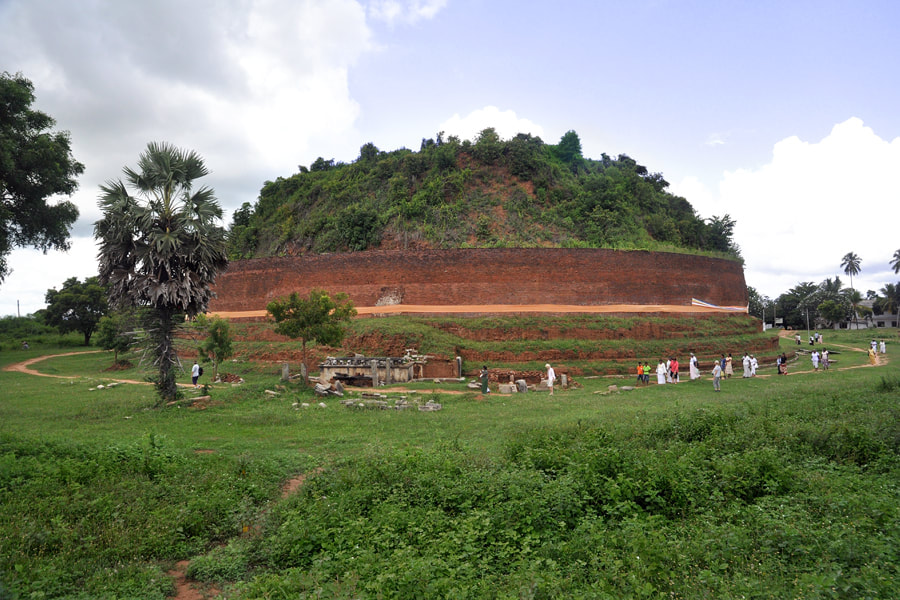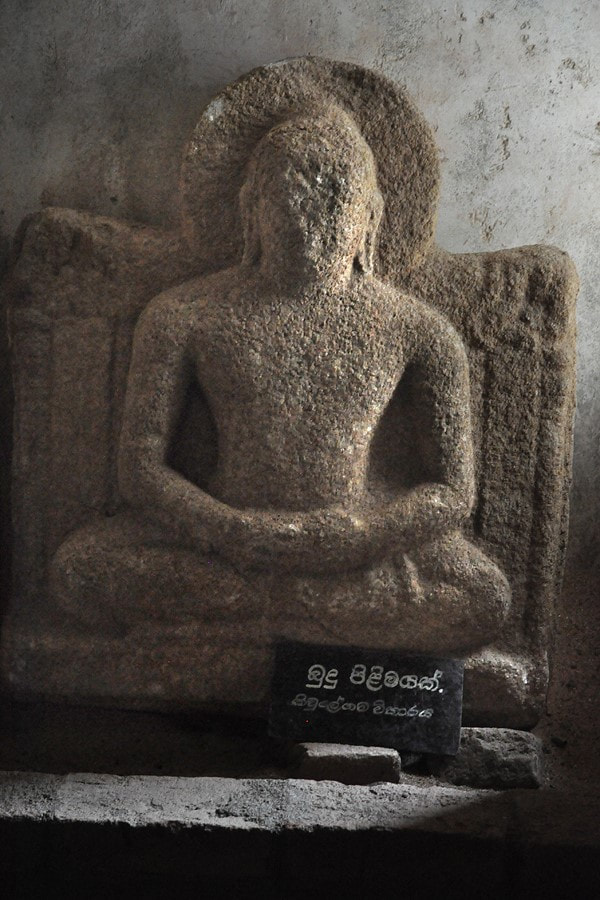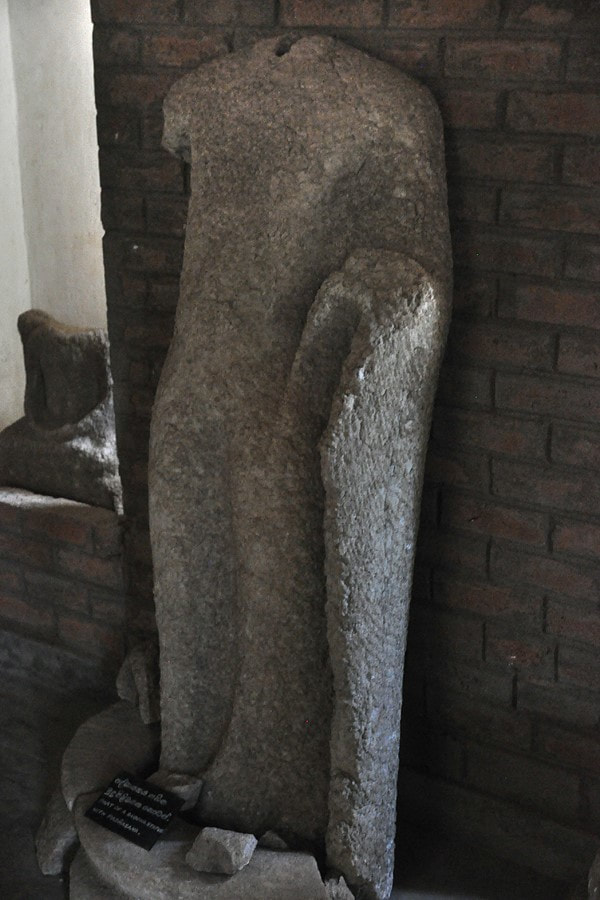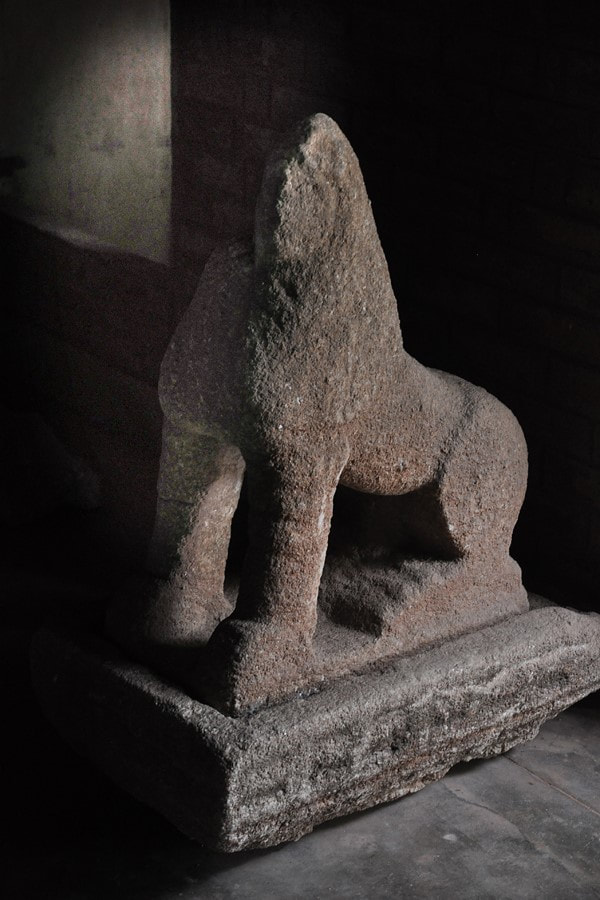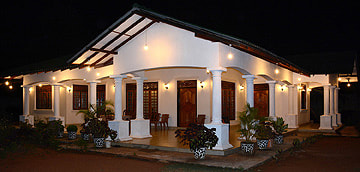Dighavapi, situated between Ampara and Oluvil, is an important excavation site and the largest ancient stupa in eastern Sri Lanka. According to the ancient Mahavamsa chronicle, Dighavapi is one of the places visited by the Buddha during his third and final stay on the island. Thereby, it is counted as one of Sri Lanka’s 16 sites called Solosmasthana. This is why this stupa is an major Buddhist pilgrimage site in the Eastern Province. A new image hall has been constructed near the Dighavapi stupa. A small archaeological museum is at the entrance gate of the Dighavapi archaeological site.
Location
|
Dighavapi is located less than 9 km from the eastern shores near Oluvil and Palamunai, as the crow flies. The degree of longitude is only 0°05.5' weest to the easternmost meridian of the island. The stupa and monastery is situated 18 km east of Ampara by road. The next major city (with more than 100,000 inhabitants) is Kalmunai at the east coast, 24 km northeast of Dighavapi. The next tourist hubs is the area of Pottuvil and Arugam Bay about 70 km further south by road.
|
Name
Due to several archaeological findings such as inscriptions and, mainly, because of Sri Lanka‘s only giant stupa from the Anuradhapura-period outside Anuradhapura town, Dighavapi deserves to be called the most important archaeological site of Ampara District, which is the southernmost of the three districts of the Eastern Province. Actually, the name „Dighavapi“ is related to the historical name of the Ampara region, „Dhigamadulla“ (which derives from „Dhiga-Mandala“ and means „Digha-Circle“ or „Digha-District“), which is sometimes used as the adminitrative and electoral district‘s name even today.
The name simply means „long tank“. Some historians believe that this refers to one of the historical tanks in the region, R. L. Brohier proposed it was the tank now known as Mahakandiya Wewa, which is also known as Kandia Kattu in Tamil. This tank seems to have been larger and of an elongated shape in ancient times, though it is not that long any more. However, the name‘s reference to this specific tank in 24 km distance is not at all certain, because there are several other historical tanks much closer by, but none of them being apparently long. The ancient place name of the monastery and stupa could habe been meant merely poetical instead. An alternative derivation of the name is that it refers to the settlement‘s founder called Dighayu, who was one of the earliest Sinhalese migrants to the island, see below in the „History of Dighavapi“ section. „Dighavapi“ is pronounced with a long first „i“ and therefore often transcribed „Deeghavapi“ or „Deegavapi“ in English. |
Dighavapi as a
|
What to see at Dighavapi
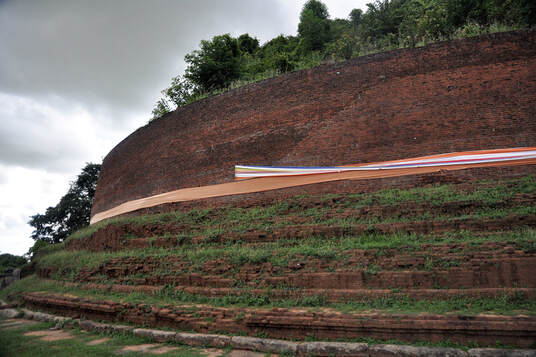
The main attraction of Dighavapi is the monumental ancient stupa, which might well be one of the three earliest giant stupas, built in the 3rd century BCE. The diameter of the stupa is almost 100 meters and it has been restored up to 10 meters in height. The unrestored center still reaches a height of more than 35 m and the original stupa was definitely much higher. But it is not quite certain if it had a dome of a hemispherical shape and how large was the spine called Chattravali atop of it. Records say that the Dighavapi stupa still had a height of almost 60 m in the mid 19th century.
Another open question is if the stupa was of its final enormous size and design right from the beginning. Some stupas seem to have been enlarged or embellished several times in the course of the centuries. In particular, it‘s not unlikely that the frontispieces called Vahalkadas, highly charakteristic of Sri Lankan stupas or dagabas, had been built at the four cardinal points right from the beginning. Tpically, they are ornamented with friezes depicting animals. Remnants of carved elephant heads can still be seen at the Dighavapi Vahalkadas.
Another open question is if the stupa was of its final enormous size and design right from the beginning. Some stupas seem to have been enlarged or embellished several times in the course of the centuries. In particular, it‘s not unlikely that the frontispieces called Vahalkadas, highly charakteristic of Sri Lankan stupas or dagabas, had been built at the four cardinal points right from the beginning. Tpically, they are ornamented with friezes depicting animals. Remnants of carved elephant heads can still be seen at the Dighavapi Vahalkadas.
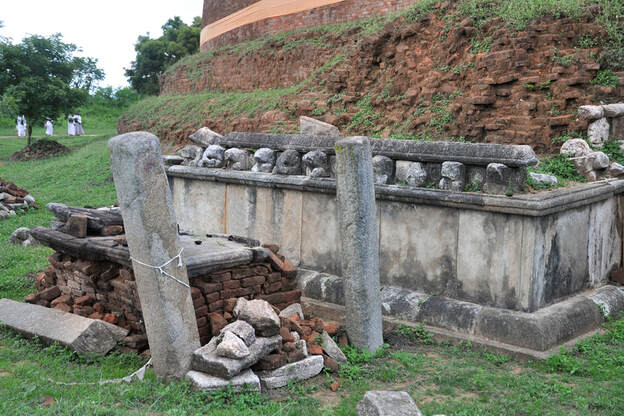
Large monolithic slabs in front of the Vahlakadas, almost undecorated, served as altars for flower offerings. They can be seen in various sizes in the case of Dighavapi, some are of impressive dimensions.
Vahalkadas were often flanked by steles that correspond to so-called Stambhas known from Indian architecture. The steles once carried the four Ashokan animals as symbols of the spread of the Buddhist Dharma into all four cardinal directions. Though the animal sculptures are missing, the steles are decorated with reliefs that are even more detailed than those of the Vahalkada friezes. A very good speciman of a decorated stele can be seen at the northern Vahalkada of the Dighavapi dagaba. By the way, one stele in the plains around the stupa is believed to mark the place of a buried treasure, according to local legends.
Vahalkadas were often flanked by steles that correspond to so-called Stambhas known from Indian architecture. The steles once carried the four Ashokan animals as symbols of the spread of the Buddhist Dharma into all four cardinal directions. Though the animal sculptures are missing, the steles are decorated with reliefs that are even more detailed than those of the Vahalkada friezes. A very good speciman of a decorated stele can be seen at the northern Vahalkada of the Dighavapi dagaba. By the way, one stele in the plains around the stupa is believed to mark the place of a buried treasure, according to local legends.

Sculptures that were sometimes posted in front of Vahalkadas or flanking them, one of them still in situ at the southern side, are definitely from post-Christian centuries, even if the stupa construction had been started in the third century BCE.
Earlier representations of the Buddha than those in human form are of a symbolic type, for examples images of trees of enlightenment. A characteristic form of Buddha symbol in Sri Lanka, continued to be used till the present day, is the footprint, as the believe that the Buddha left his footprint on the island‘s sacred mountain Siri Pada (Holy Foot) seems to be even older than the surviving ancient chronicles that make mention of it. Slabs depicting just flat convex or concave soles of two feet, often in a very stylised way, can be seen near the Vahalkadas of the Dighavapi stupa as well. They are called „Siripatulgala“, which simply translates to „Holy-Foot-Stone“.
Earlier representations of the Buddha than those in human form are of a symbolic type, for examples images of trees of enlightenment. A characteristic form of Buddha symbol in Sri Lanka, continued to be used till the present day, is the footprint, as the believe that the Buddha left his footprint on the island‘s sacred mountain Siri Pada (Holy Foot) seems to be even older than the surviving ancient chronicles that make mention of it. Slabs depicting just flat convex or concave soles of two feet, often in a very stylised way, can be seen near the Vahalkadas of the Dighavapi stupa as well. They are called „Siripatulgala“, which simply translates to „Holy-Foot-Stone“.
As a visitor you should follow the tradition of Buddhist pilgrims and circumfere the stupa only in clockwise direction, just as a matter of politeness, if not in expectation of better auspices.
Some of the findings of the large archaeological site and surroundings are now excavated in the small museum, which is located not far from the stupa and right at the car park. The interior of the museum is a little bit dark. A nice lion statue, measuring half a meter in height, is quite well preserved. A torso of a Buddha statue can also be seen, though most statues excavated in and around Dighavapi are now in larger archaeological museums. The front yard of the museum exhibits a typical Ayurvedic tub of ancient or early medivel sanatories, once used for herbal bathes. Remnants of foundation walls of such an original Ayurvedic hospital are said to have been destroyed by modern construction works. Another item often seen in monastic complexes of the late Anuradhapura period (8th to 10th century) are urinal stones, a specimen can be seen here at the Dighavapi museum, too.
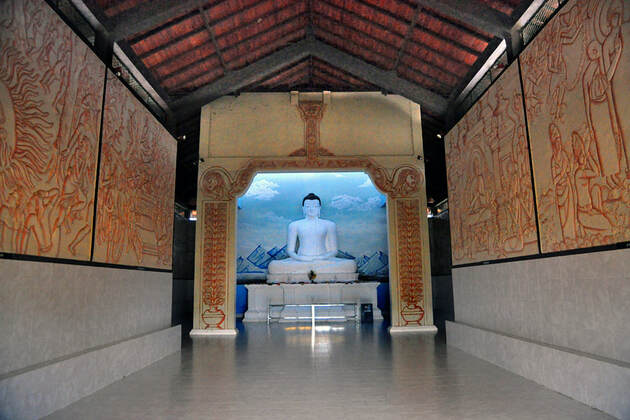
Be aware, that Dighavapi like many other archeological sites and cultural sightseeing attractions in Sri Lanka is a living heritage. The stupa is now part of an reestablished Buddhist monastery. A typical so called Pilimage (image house) has been newly constructed just to the east of a stupa. It serves pilgrims for worshipping a Buddha statue. The walls of the otherwise plainly designed and modestly decorated shrine room carry colourful modern carvings depicting scenes from the Buddhist history of Sri Lanka, e.g. the legendary visits of the Buddha Shakyamuni to the island.
a miracle at Dighavapi reported in an ancient commentary
A pious legend connected with the Dighavapi has it that a novice fell from the top of the stupa when he was helping to plaster it. However, while he was falling down his companions advised him to chant the the Dhajagga Sutta from the collection known as Samyutta Nikaya. In general, this canonical text is recommended to be recalled by monks in fear. The falling novice, reciting these words of the Buddha, was miraculously saved. The story is reported in a commentary to the Samyutta Nikaya.
History of Dighavapi
Pre-Buddhist Sinhalese period
Though the common interpretation of the name „Dighavapi“ is the literal translation „long tank“, there is an alternative etymology deriving the name from „Dighayu“, who was one of six brothers of Queen Baddhakatyana and thereby a brother in law and minister of King Panduvasudeva. The latter is mentioned in the chronicles as a pre-Buddhist king reigning around 500 BCE. According to the chronicles many of the important later towns such as Anuradhapura were founded by and named after leaders of the earliest Sinhalese settlers. In this case, Dighavapi would be one of the earliest Sinhalese settlements on the island. This hypothesis makes sense indeed, as it would be quite understandable that a later stupa of such significance would not have been erected in a wilderness but in or near a well-established settlement.
Era of Dutthagamani and Saddhatissa
The construction of a large stupa at this site is attributed to no less than Saddhatissa, the younger brother and successor of Dutthagamani (Dutugemunu), the Sinhalese national hero, a kinf of the Rohana in the southeastern part of Sri Lanka rwho requoncered Anuradhapura in the 2nd century BC. This is said to be confirmed by an inscription found in the vicinity of Dighavapi, which makes mention of Saddhatissa indeed. However, it does not make mention of him as the founder of the stupa. However, there is some intimate connection of Saddhatissa with this ancient region according to the chronicles. Even before the war for Anuradhapura, Saddhatissa had been entrusted by his father Kakavantissa with ruling this norther part of his Rohana kingdom. When the king died, Saddhatissa soon launched a war of succession against his elder brother Dutthagamani. In preparation for it, he retired to Dighavapi with his mother and the elephant Kandula. It‘s highly likely that the Ampara alias Dighamadulla region in between the core area of Rohana and the border to the Anuradhapura kingdom at the Mahaweli river after the reconciliation of the two brothers served as a major supply hub of the Sinhalese troops during the decade-long campaign of Dutthagamani against the Tamil king Elara of Anuradhapura. After Dutthagamani gained power in Anuradhapura, he appointed his younger brother Saddhatissa ruler of that eastern part of the island. This can be seen from the fact that he was called back from there at the time of Duthagamani's death (according to Mahavamsa chapter 32, verse 2).
It had been under the reign of Dutthagamani that the first stupas of this record-breaking size were erected in Sri Lanka, namely the Mirisaveti Dagoba and the even larger Ruwanweliseya in Anuradhapura. His successor Saddhatissa may well have been eager to imitate this large-scale construction program in and might therefore have chosen Dighavapi, the administrational and cultural center of his home-province. The chronicle attributes the founding of a monastery in this region to Saddhatissa (Mahavamsa chapter 33, verse 3) and - in contrast to other Viharas, which were built in regular distances of about 15 or 20 kilometers along the road from Anuradhapura to Dighvapi - explicitely makes mention of the construction of a chetiya, a stupa, at the Dighavapi Vihara (in the following verse 4).
It had been under the reign of Dutthagamani that the first stupas of this record-breaking size were erected in Sri Lanka, namely the Mirisaveti Dagoba and the even larger Ruwanweliseya in Anuradhapura. His successor Saddhatissa may well have been eager to imitate this large-scale construction program in and might therefore have chosen Dighavapi, the administrational and cultural center of his home-province. The chronicle attributes the founding of a monastery in this region to Saddhatissa (Mahavamsa chapter 33, verse 3) and - in contrast to other Viharas, which were built in regular distances of about 15 or 20 kilometers along the road from Anuradhapura to Dighvapi - explicitely makes mention of the construction of a chetiya, a stupa, at the Dighavapi Vihara (in the following verse 4).
Golden Inscriptions of Kanitthatissa
In 1986, a gold leaf inscription was unearthed that measured 14 cm in length and 1.5 cm in width and was in a reliquary made of thicker gold sheets. The inscription reads: “Hail. The stupa (reliquary) of King Mahitisa (Kannittha Tissa) son of King Naka”. King Kannittha Tissa reigned in the late 2nd century CE. (According to alternative datings of Sinhalese monarchs he reigned in the first half of the 3rd century.) In the Mahavamsa, he is credited with numerous construction and restauration works, some of them quite ambitious. For example, he built the Abhagari‘s famous chapter hall known as Ratanapasada in Anuradhapura and several more edifices for this largest monastery of the capital. He also built a stupa on the Ambasthala platform in Mihintale. Usually this gold leaf inscription is interpreted as referring to a restauration. However, it was found near one of the large frontispieces of the stupa. This might indicate, that the groundplan of the Dighavapi stupa reached its final size and its decoration during the reign of Kanitthatissa.
Dighavapi in post-Anuradhapura periods
For the second half of 12th century, A sequel of the Mahavamsa (sometimes called the Chulavamsa) mentions Dighavapi in connection with the campaigns of Parakkamabahu I (several times in chapter 74) against a rebellion in the aready conquered southern province of Rohana.
From the first half of the 17th century onwards, Muslims settled in this area. They were descendants of Arabs and had originally settled in the western coastal plains but had to flee to the Kandyan kingdom due to persecution by the Portuguese between 1526 and 1626. King Senerat granted a new settlement area to the Muslim community, they were decreed to settle in the hilly Welassa region just east of Badulla, but from there they gradually moved to the eastern plains. Ampara District alias Dighamadulla has been one of the core areas of Sri Lanka‘s muslim population ever since.
In 1638 CE, Senrath‘s successor Rajasinghe II granted the coastal area near Dighavapi to the Dutch, whom he considered his allies against the Portuguese. Some descendants of Dutch settlers still live in the area, though the bulk of the so-called Burghers migrated to Australia and other countries after independence of then Ceylon from colonial rule.
An inscription found at Dighavapi – which regrettably gone lost in the meantime, but a copy from 1845 still exists – confirns that King Kirthi Sri Rajasingha (1747-87) ordered renovation works in 1756. Kirthi Sri Rajasingha, maybe in an attempt to compensate the Southindian and Tamil origin of his dynasty, turned out to be a diligent renovator of Sri Lankas ancient Buddhist monasteries in general. For example, much of the interior of the world-famous Dambulla caves has also received its final appearance during his reign and he restored the Buddhist monastic lineage by supporting the reintroduction of a line of succession from Thailand, then known as Siam. According to the lost inscription, the king endowed the chief monk Bandigide Negrodha Thero with the supervision of the reestablished Dighavapi monastery and donated land of 1000 Amunu (more than 500 hectared) for the maintainance, as it was common that paddy farmers of such temple land paid taxes for the livelihood of the monks.
In the 19th century, the British colonial rulers took over the land that had belonged to the temple. In 1886, the British governor of Batticaloa ordered to remove bricks and granite slabs to be used for nearby irrigation projects. Another purpose of this act of vandalism was to destroy Buddhist heritage in favour of the Christian religion. Though pious Buddhist villager refused to take part in such desacralising activities, the stupa was further damaged with the help of Muslim workers during this period.
In 1916 finally a the Buddhist monk Kohukumbure Revatha started a redevelopment campaign at this temple compound. He was murdered by a local Muslim in 1950. Land disputes and rivalries concerning distribution of irrigation water remain to be a root cause of ethnic tensions in the area.
From the first half of the 17th century onwards, Muslims settled in this area. They were descendants of Arabs and had originally settled in the western coastal plains but had to flee to the Kandyan kingdom due to persecution by the Portuguese between 1526 and 1626. King Senerat granted a new settlement area to the Muslim community, they were decreed to settle in the hilly Welassa region just east of Badulla, but from there they gradually moved to the eastern plains. Ampara District alias Dighamadulla has been one of the core areas of Sri Lanka‘s muslim population ever since.
In 1638 CE, Senrath‘s successor Rajasinghe II granted the coastal area near Dighavapi to the Dutch, whom he considered his allies against the Portuguese. Some descendants of Dutch settlers still live in the area, though the bulk of the so-called Burghers migrated to Australia and other countries after independence of then Ceylon from colonial rule.
An inscription found at Dighavapi – which regrettably gone lost in the meantime, but a copy from 1845 still exists – confirns that King Kirthi Sri Rajasingha (1747-87) ordered renovation works in 1756. Kirthi Sri Rajasingha, maybe in an attempt to compensate the Southindian and Tamil origin of his dynasty, turned out to be a diligent renovator of Sri Lankas ancient Buddhist monasteries in general. For example, much of the interior of the world-famous Dambulla caves has also received its final appearance during his reign and he restored the Buddhist monastic lineage by supporting the reintroduction of a line of succession from Thailand, then known as Siam. According to the lost inscription, the king endowed the chief monk Bandigide Negrodha Thero with the supervision of the reestablished Dighavapi monastery and donated land of 1000 Amunu (more than 500 hectared) for the maintainance, as it was common that paddy farmers of such temple land paid taxes for the livelihood of the monks.
In the 19th century, the British colonial rulers took over the land that had belonged to the temple. In 1886, the British governor of Batticaloa ordered to remove bricks and granite slabs to be used for nearby irrigation projects. Another purpose of this act of vandalism was to destroy Buddhist heritage in favour of the Christian religion. Though pious Buddhist villager refused to take part in such desacralising activities, the stupa was further damaged with the help of Muslim workers during this period.
In 1916 finally a the Buddhist monk Kohukumbure Revatha started a redevelopment campaign at this temple compound. He was murdered by a local Muslim in 1950. Land disputes and rivalries concerning distribution of irrigation water remain to be a root cause of ethnic tensions in the area.
